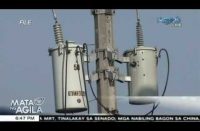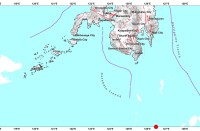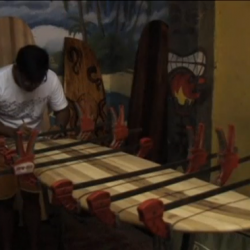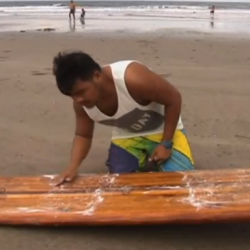Filipino surfing enthusiast creates eco-friendly surfboards using recycled wood in an effort to shift focus towards sustainability and craftsmanship. (Photo captured from Reuters video)
For Jay-ar Domantay surfing is a way of life. It’s the reason he traded in a fast paced career in Manila to build old fashioned surfboards made from recycled wood.
29-year-old Domantay quit his job in events management to become a surfboard shaper.
He named his workshop in a southern Manila neighborhood Tree to Sea, where the ethos is simplicity and craftsmanship.
“This wooden surfboard, this wooden surfboard is not for competition. It cannot outperform the newer surfboards. But it will help you to become more simple. Your approach to the world around you will be simpler. You will know that what is more important is the ride, the joy you get from it, rather than showing off,” Domantay said.
Fiberglass boards dominate the market because they are lighter and easier to maneuver. Wooden boards are not designed for competition, but are valued for their craftsmanship.
Before the advent of fiberglass all surfboards were made of wood, Domantay takes it one level further and recycles scrap wood for his boards, advocating a sustainable approach to his craft.
He scrounges around lumber yards and furniture shops to look for discarded wood. He says wood from the Paulownia tree and western Red Cedar are ideal for making surfboards and when he can’t find the perfect piece he orders materials from a website promoting sustainable forests.
He is very particular about the wood he uses, and avoids timber that is illegally logged.
Domantay stresses he doesn’t need perfect-looking wood but a cut with marks that make it distinct. Then with a hand plane, he carves his boards using the “chamber” process, shaping it from one solid plank of wood and carving holes inside, instead of the more common method of sticking pieces of wood together to form a skeleton.
Once carved and chambered, the board rests and adapts to the temperature before the pieces are fitted together in a process called “decking”. Domantay uses minimal electricity to prevent the cracking of wood.
He says it could take months to finish a board.
“Who would have this kind of patience, just to own a surfboard, to wait for eight months? But then the story behind it – that I found these pieces of wood while visiting countless lumber yards, that I incorporate the stories of the people who told me how they found the wood — you sum it up and it becomes one piece,” he said.
Priced at 40,000 Philippine pesos ($857 USD) each, Domantay’s creations have become collector’s items, sold to surfers in the Philippines and overseas.
Surfing has attracted hordes of enthusiasts in recent years, thanks to hotspots like Siargao, frequented by international competitors. Daet, where Domantay surfs, and other sites have gained popularity too, and offer courses for amateurs.
But many surfers who live in communities like Bagasbas village in the town of Daet, say the sport is not easy on the pocket.
“Here in the Philippines, the surfing community is poor, especially here in Daet. It’s hard to find surfboards, they’re expensive. But somehow we can survive. At least we can buy second hand,” Bagasbas beach surf instructor Mocha Vargas.
Domantay’s idea of recycling is catching on. Other surfers like fisherman Aries Cliones reconstructs damaged surfboards to minimize cost. But unlike Domantay, he uses simpler tools like a farmer’s machete to shape the boards, and sometimes finds pieces from an old fisherman’s paddle.
“You may find beautiful boards, but they would be expensive, so we cannot afford them. So we choose the cheaper option, even if it’s damaged. Even if it’s a wooden board that is broken, but it is cheap, we’ll get it. We can repair it. Wood is easier to repair than fiber glass,” Cliones said.
Surfers in Bagasbas say they hope Domantay can produce enough wooden surfboards to allow him to lower his prices, allowing more local surfers to afford his eco-friendly boards.









